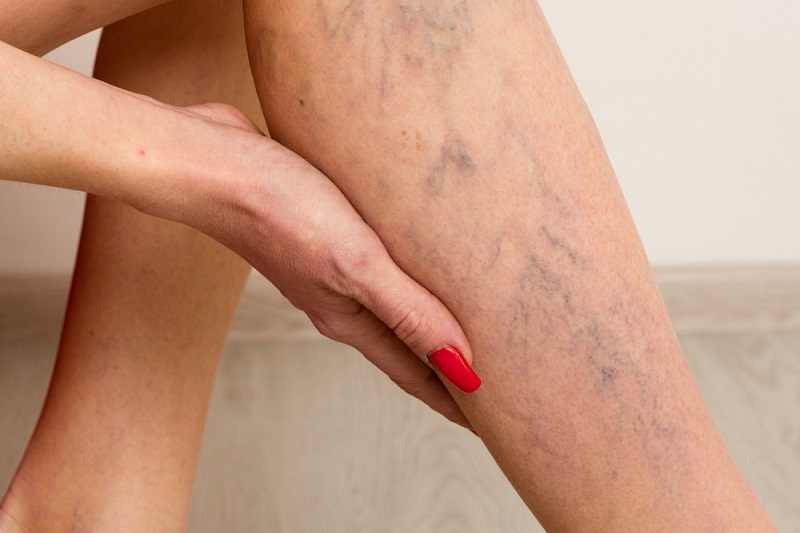Dr. Vaibhav Lende | Vein Treatment Specialist & Vascular Surgeon In Nagpur
Varicose Veins

Causes
Varicose veins result in increased blood pressure the veins. Normally, veins have one-way valves to prevent blood from flowing backward as it returns to the heart. When these valves fail, blood can pool in the veins, causing them to enlarge. Some common causes include:
- Aging: Veins lose elasticity as people age, and valves in veins may weaken, leading to blood flow reversal.
- Genetics: A family history with varicose veins can increase the likelihood of developing them.
- Obesity: Extra weight may put pressure on veins increasing the risk.
- Prolonged standing or sitting: Occupations that require long periods of standing can reduce circulation, leading to vein issues.
- Pregnancy: Increased blood volume and hormonal changes can cause veins to enlarge, and the growing uterus adds pressure on pelvic veins.
- Hormonal influences: Hormonal changes during puberty, pregnancy, and menopause can increase risk, especially in women.
Symptoms
Varicose veins can vary in appearance and cause symptoms that range from mild to severe:
- Visible, twisted veins: Usually bluish or purple in color, varicose veins appear swollen and bulging on the surface of the skin.
- Aching or heaviness in the legs: Often worse after prolonged sitting or standing.
- Swelling: In the lower legs and ankles.
- Pain or discomfort: Some experience burning, throbbing, or cramping sensations.
- Itching: Particularly around the vein area.
- Skin discoloration: In severe cases, the skin around the veins may darken or develop ulcers
Diagnosis
Diagnosis generally involves a physical examination by a healthcare provider, who will look for visible signs of varicose veins. In some cases, an ultrasound is used to check blood flow and rule out other conditions like blood clots.
Treatment
While varicoseveins aren’t always harmful, treatment is often pursued for cosmetic reasons or to relieve symptoms. Treatments vary based on severity and can include:
Lifestyle Modifications
- Exercise: Regular movement helps improve circulation and reduces vein pressure.
- Weight management: Maintaining a healthy weight can reduce pressure of veins.
- Elevating the legs: Promotes blood flow back to heart, easing pressure in the legs.
- Compression stockings: These help veins move blood by applying pressure, reducing swelling and discomfort.
Medical Treatments
- Sclerotherapy: A chemical solution is injected into vein causing it to collapse and fade over time. This is effective for smaller varicose veins.
- Laser treatment: A non-invasive treatment where laser energy is used to close off small varicose veins and spider veins.
- Endovenous laser therapy (EVLT) and radiofrequency ablation (RFA): Minimally invasive procedures where heat or laser energy is used to seal off larger varicose veins.
- Vein stripping and ligation: Surgical removal of larger varicose veins through small incisions. Generally done in severe cases.
- Ambulatory phlebectomy: Removal of smaller veins through tiny skin punctures, typically performed on an outpatient basis.
Home Remedies
- Regular exercise: Strengthens leg muscles, improving circulation.
- Diet changes: Reducing salt and increasing fiber intake to prevent water retention and reduce swelling.
- Avoiding high heels and tight clothes: High heels can restrict circulation, while tight clothes may compress veins.
Complications
While varicose veins are often harmless, they can occasionally lead to complications, such as:
- Ulcers: Painful sores can form on the skin near the varicose veins, especially around the ankles, due to long-term fluid buildup.
- Blood clots: A condition called superficial thrombophlebitis may occur, causing pain and swelling due to clots in veins close to the skin.
- Bleeding: Varicose veins near the skin may burst due to minor trauma, causing bleeding.
Prevention
Some measures which help prevent or reduce the risk of varicose veins:
- Exercise regularly to promote healthy circulation.
- Maintain a healthy weight to avoid extra pressure on leg veins.
- Avoid prolonged sitting or standing try move around every hour.
- Wear compression stockings if recommended, especially if you’re prone to varicose veins.
- Elevate your legs when resting, which helps blood flow back toward the heart.
